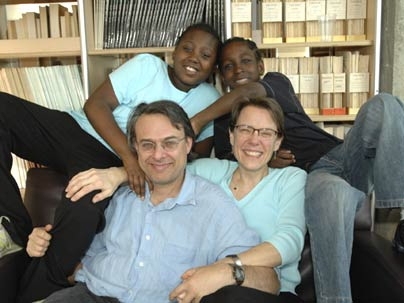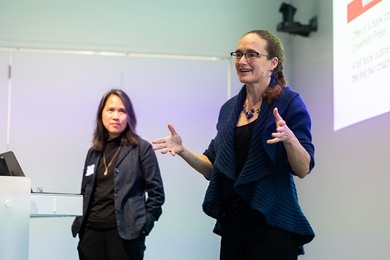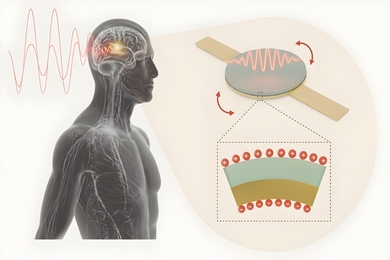A village of children is raising new families, and "Adoption Matters," a book of essays co-edited by Sally Haslanger, professor of linguistics and philosophy, portrays the ways that families formed through adoption are altering how we define "family," "mother" and even, "love."
That village among us is 6 million strong--the current estimate of the number of adoptees in America-with 1.5 million under the age of 18. Most of those children live or have lived in new kinds of families-families inclusive of birth mothers and adoptive parents; families with international and racial diversity; single-parent families; and families where there are two moms or two dads.
"Adoption Matters" (Cornell University Press), which came out this month, offers 13 essays that combine personal experience within these new families-the growing village--with a feminist and philosophical framework through which to envision the implications of adoption for policy, culture and ideas about identity in the United States.
Haslanger's own experience dramatically and movingly illustrates the book's double purpose. Like most of the essayists, she is an adoptive mother and a philosopher.
Haslanger and her husband, Steve Yablo, MIT professor of philosophy, are both white; they adopted two black children, Zina, 8, and Isaac, 10. Haslanger was present at Zina's birth; Isaac joined their family when he was 4 weeks old.
Haslanger and Yablo were chosen to be the adoptive parents by the birth mother (in Isaac's case) and by the birth parents (in Zina's case). "Their birth families are tremendously supportive of us," Haslanger said. The resulting large, extended family has maintained mutual contact, including visits back and forth among parents, siblings and grandparents (see excerpt).
Haslanger's interest, she writes in her own essay, "You Mixed?" is in how racial identity can be "disrupted and transformed."
Her own "racial identity has changed tremendously through the experience of parenting Black children. ��� As I've emphasized, I am not marked as of African descent. But as a parent of children who are, my day-to-day life is filled with their physical being and social reality, and by extension, the reality of their extended families and their racial community. And their realities have in an important sense become mine," Haslanger writes.
In conversation, she added that local community culture has a role, too. "Zina has never been the only transracially adopted child in a school classroom in Cambridge," Haslanger said.
The essays in "Adoption Matters" explore the "contrast and overlap between the family as a social association and the family viewed as a natural or biological entity," the editors write in their introduction. Historically, "kith" has referred to the former and "kin," to the latter, they note, and they suggest adoption animates both in new ways.
Charlotte Witt, Haslanger's co-editor, includes an adopted daughter in her family. Witt, professor of philosophy and humanities at the University of New Hampshire, explores the social and personal impact of narratives of family resemblance-"You have Uncle Murray's eyes!" "Heath women should never drink!"-in her essay, "Family Resemblances: Adoption, Personal identity and Genetic Essentialism."
In "Being Adopted and Being a Philosopher: Exploring Identity and the 'Desire to Know' Differently," essayist Kimberly Leighton reports her experience as an adopted child who, as a young adult, sought-and located-her birth mother and now includes her along with her parents as "family." Leighton teaches philosophy at Cornell.
Other essays trace directly the contrast between what's considered "normal" for families according to legal and social policy and what is real life among contemporary kith and kin.
Excerpt
From "You Mixed?" an essay by Sally Haslanger, MIT professor of linguistics and philosophy, in "Adoption Matters: Philosophical and Feminist Essays" (Cornell 2005).
Sometimes, through parenting a child of another race, one is drawn into cultural rituals concerning the body. In the case of White parents of Black children, the most obvious are the rituals of caring for hair and skin. I remember vividly our first trip to a Black barbershop for Isaac's first haircut, our anxiety at crossing an important color line. Having moved several times since Isaac joined our family, each time we've had to negotiate the dynamics of entering with him a predominantly Black male space. And when Isaac met his birth grandparents for the first time (we visited them for a long weekend), one of the most important trips of the weekend was to the barbershop, where we were introduced as family.
The issue of girls' hair is even more laden and contested: a friend and mentor confided in me shortly after our daughter Zina joined our family that when she gave birth the second time and the doctor announced, "It's a girl!" the very first thing that went through her mind was, "Oh my gosh THREE heads of hair to do each morning!" I had only the vaguest appreciation of what she meant until I found myself trying to comb out my sleeping (toddler) daughter's hair to find myself two hours into it with her awake, screaming, and me in tears. But I have been guided and coached by friends and acquaintances, by beauty store clerks, the crowd at the barbershop, by Zina herself.
A version of this article appeared in MIT Tech Talk on April 13, 2005 (download PDF).






